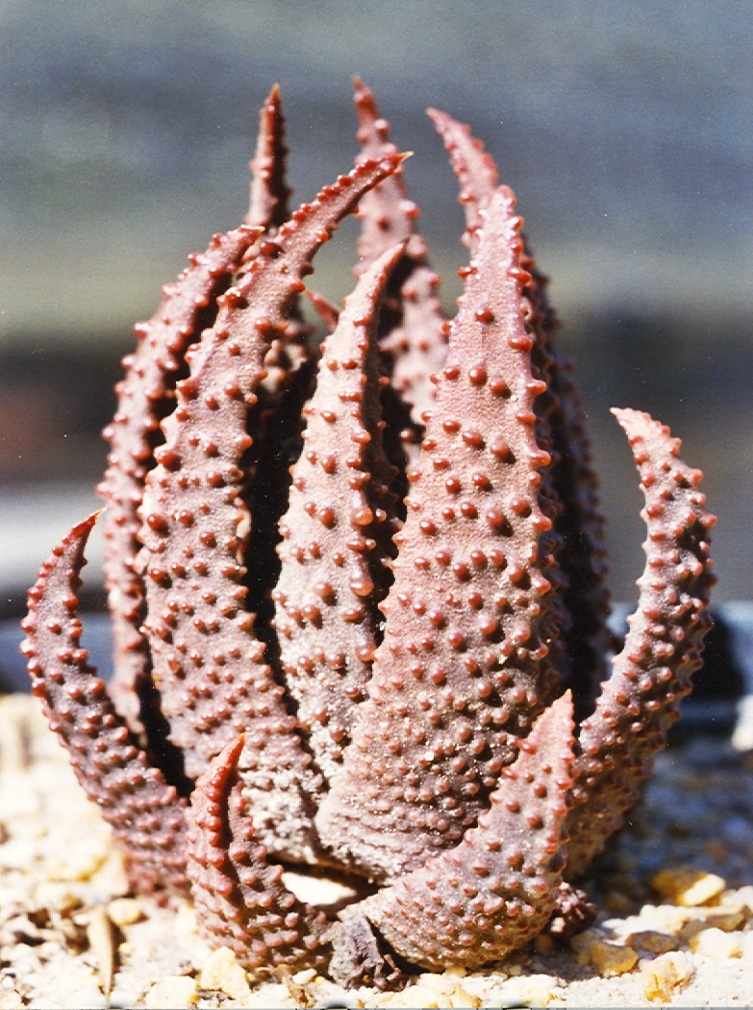Wheee! I want to give some Tulista pumila seed with a name to the Arboreta Nurseries propagator. … Just what does the nursery use for a community that at some levels calls Aloes cactus? I started a draft of an addition to my book chapter on name issues. Here is the start.
Tulista pumila into commercial markets.
Perhaps it would be useful to follow a path of the introduction of a new species into a commercial nursery. Tulista pumila is the name accepted by the South African National Botanical Institution (SANBI). The International Organization for Succulent Plants (IOS) does not agree and uses Haworthia maxima. I did write in Alsterworthia an article about this truly ridiculous process of name changes that this poor species has gone through since Linnaeus fluffed the issue. It is a mind boggling tale of sheer nonsense that we call science. A short version of the story is that I settled on Haworthia pumila following Dr. Codd (assisting Col. C.L. Scott) and my own simple understanding of the nomenclatural rules and my own intellectual grasp of the process. It is carefully explained in my Haworthia revision (Haworthia Revisited, 1999) including several statements that I was trying to minimise the impact of a name change on the community that might need such a formal name. Do not get me on to the even more idiotic change of names from my H. minima to Tulista minor.

This is not T. pumila (or do you use H. maxima). It is that genetic anomaly at Lemoenpoort that another authority has a species name for. Adding to the confusion (conflation) of names between “science” and the “layman”. Should it be T. pumila ‘Lemoenpoort’ to send purists conservationists into a frenzy?
Half a century ago, as a very small child, I wandered the then named Karoo Garden reading and recognizing “Haworthia margaretifera” on standardized garden labels. Later in my early teens the name “pumila” arrived and brought with it a measure of confusion as to what this meant and why it may be necessary. With it came almost a personality change in my experience of the plants. In hindsight, it feels to me a name change invalidates all preceding literature and interrupts the easy flow of language and the communication I expect it to bring.
The variation of T. pumila around Worcester is interesting. With so many populations of the more “typical” colour and shape, Lemoenpoort looks like just extraordinarily beautiful variant. If “maxima” ought ever to apply, I wish the author of the name had seen the huge plants at the airfield in the 1980’s. And this speaks to my speculation on the almost infinite age of these plants and the continuous growth via a terminal bud.
~ Warwick Bayer
Arthur Dixon asked “How big is big?”
Bruce Bayer answered … 20cm diam and 35 cm tall? In some populations they are small and a population in the Bontebok park that I did record as minima (8cm diam) is possibly T. pumila? If they are separate systems and depending on just what your perception is of “species”
Maxima actually referred to one of 4 variants of aloe pumila (the smallest aloe) and maxima was the largest of them. So the nomenclatural rules have a flaw. Firstly it does not take into account the descriptive nature of Linnaeus names and secondly it doesn’t prioritise the actual hypothesised evolutionary changes. Forget here also the vexing question of chronology of species descriptions. The “law” does not allow for nor prevent the different interpretation of the “law”. See the way in which Australian “scientists” hijacked the name Acacia and South Africa has to settle for the name change of Vachelia. When did that happen and how long to filter through to nurseries and their clientele? When it comes to the age of these plants??? Also the nature of stemmed and stemless. Why is T. pumila (H. pumila/maxima not stemmed? I once saw a single plant in the KG veld that was about 35cm tall and stemmed. Why is it seldom ring clumped as in Aloe claviflora? But Lemoenpoort and some other populations do. Sometimes, I would say most times, they do not offset at all. Longevity? Plants have to grow to live at all. So life span is a delicate balance between the shedding and decomposition of the older leaves as the annual flush of new leaves occurs. A delicate balance of decay of the stem and capacity of the plant to keep its crown at ground level? Like Aloe dichotoma. It has often been speculated that these plants are hundreds of years old. My experience suggests a life span of about 120 Years. But it is VERY fuzzy around he edges. The story of Aloe ferox as a single plant east of Prince Albert I estimate its age at about 600 years with a single germination event about 1973 when this self-sterile single plant produced seed. No sight of another plant for miles around. More to that story and how it survived that long. Thudichum collected Aloe ferox as large seedlings at Stormsvlei, and planted them as that avenue up the KG drive, they died slowly one by one. Some were still there as those 3.5-4m giants near the nursery. This suggests a life span of about 60 years IF intervention does allow near root development and leaves getting too far away from the roots. Never once did I see a self-established seedling in the cultivated area surrounding them, nor in he natural veld also about them. Very fuzzy indeed. Do we need more evidence we live in an illusion? A dream? A projection? ♦
References:
Aloe pumila, Haworthia pumila; what or who is confused?
A new combination – Tulista minor.
